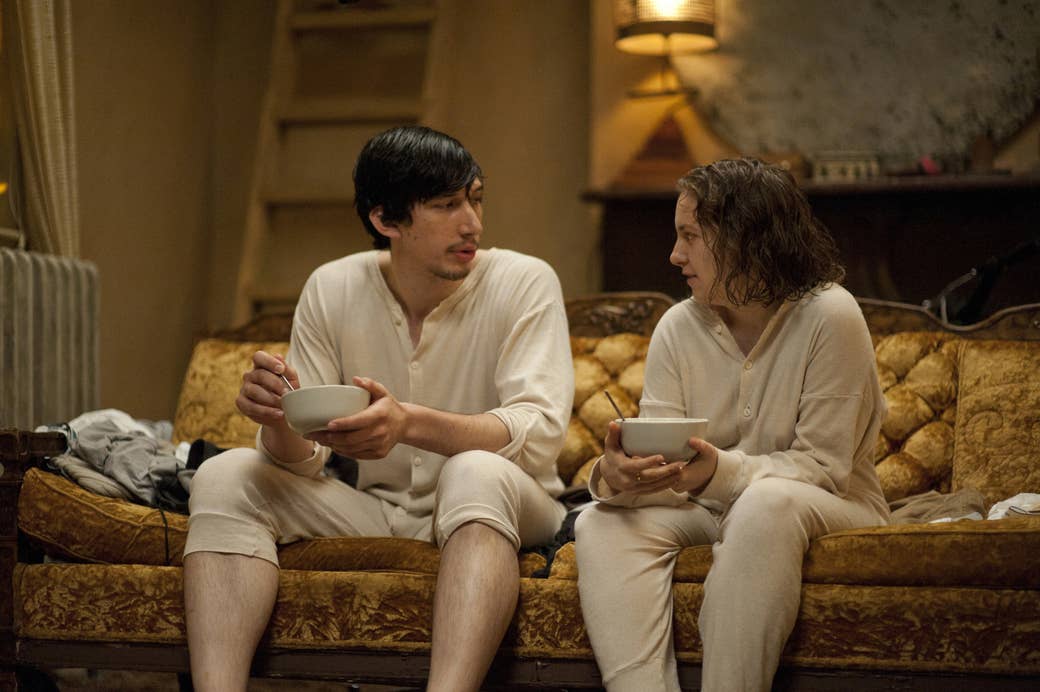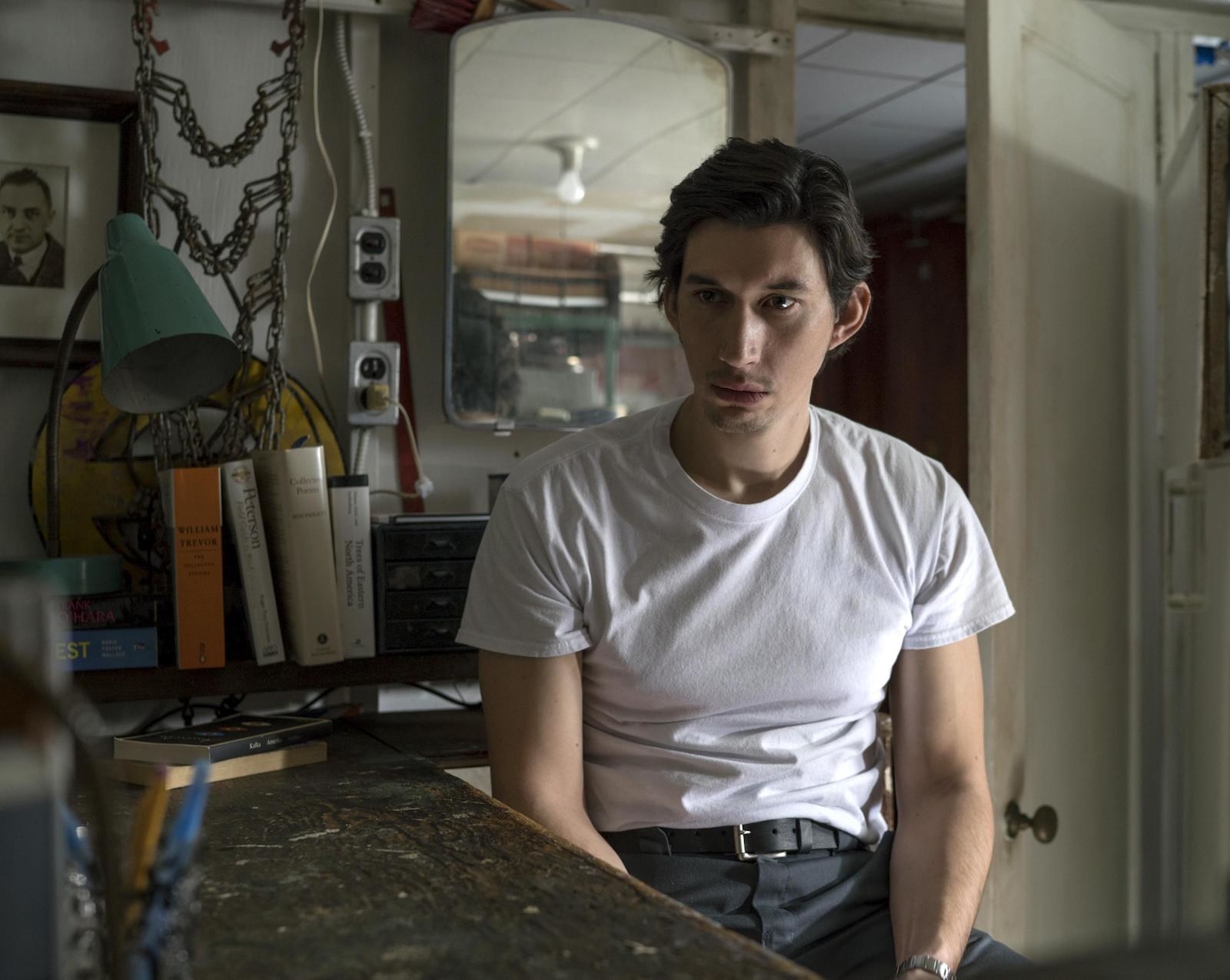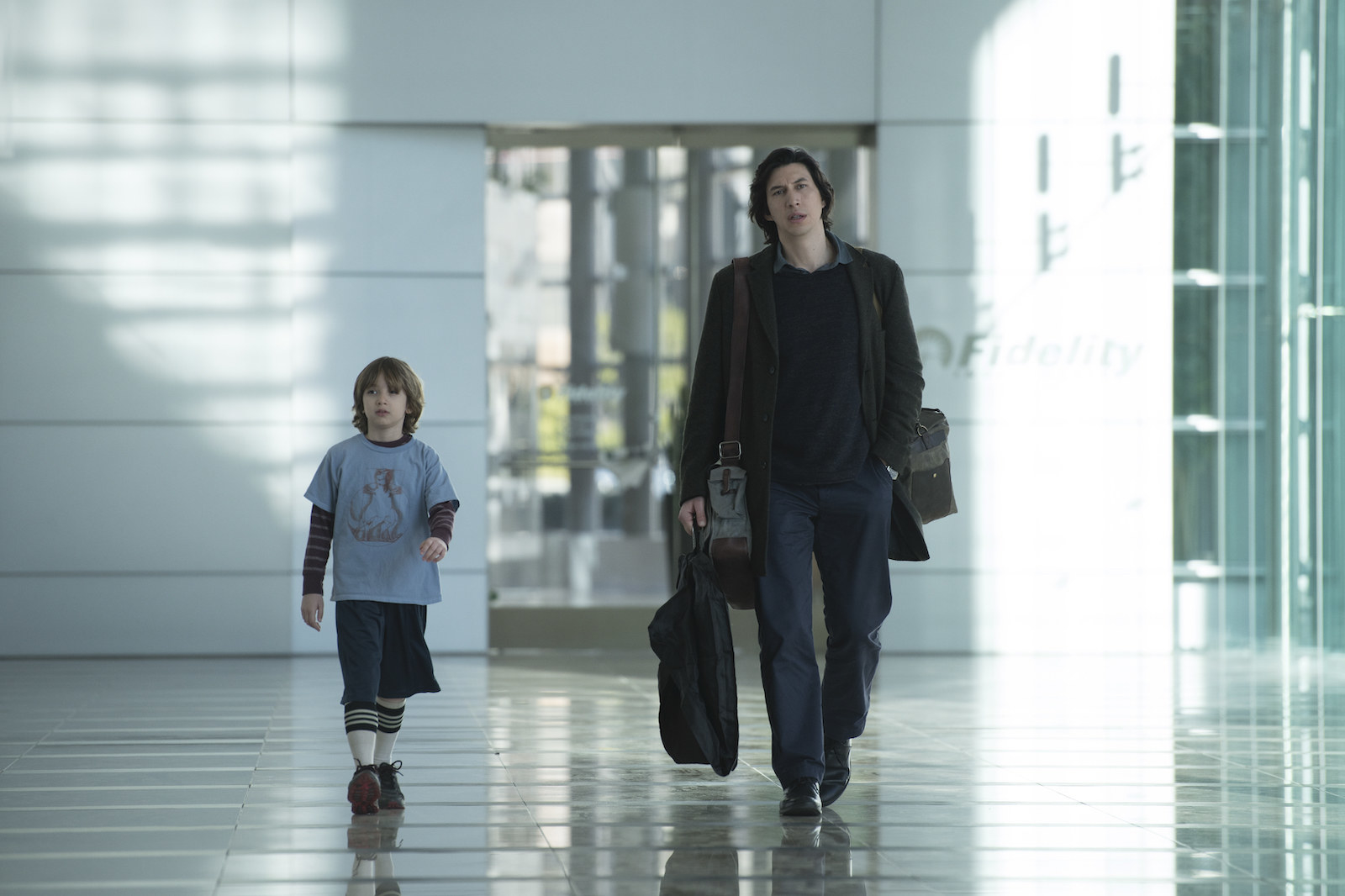
The only time I’ve seen Adam Driver in person, he was at the American Museum of Natural History in New York, his face tinted slightly blue from the light reflecting off the 94-foot blue whale that dominates the Hall of Ocean Life. It was the night of the Season 4 premiere of Girls in 2015, and the room was sprinkled with celebrities: Natasha Lyonne, Jon Hamm, Tavi Gevinson, Karlie Kloss, Nicky Hilton, and, of course, Lena Dunham, who’d cast Driver for what was originally supposed to be a one-episode appearance. At these sorts of events, celebrities are never not surrounded. But Driver was more like me: off to the side, all alone, staring into space, not making eye contact with anything except his crudités.
In hindsight, Driver was probably alone because he skipped the actual premiere — he refuses to watch himself in any performance — and showed up to the party before the rest of the fawning mob. But that vision of him, a tall beacon across the room, solitary and yet wholly unconcerned about it, has stuck with me. It’s not just that Driver seemed unconcerned with the pageantry of stardom; lots of actors, particularly men, are. It was how singular, how exceptional, he looked, even amid the sea of New York cool kids that accumulated around Dunham in those days.
From the beginning of his time in the public eye, Driver has been positioned as exceptional: in his performance as Adam Sackler, Dunham’s beguiling on- and off-again love interest in Girls; in his oft-reported backstory as the stepson of an Indiana preacher who enlisted in the Marines before making it to Juilliard; and that baritone voice, which Vulture aptly described as its own form of woodwind. And then there’s his body, which can best be described as confusingly hot, and his career choices, which have ricocheted between blockbusters (the almost-too-compelling Star Wars villain Kylo Ren), auteur passion projects (Silence, The Dead Don’t Die), and quasi-indie prestige pictures (The Report, BlacKkKlansman).
Driver is a contradiction in celebrity terms who seems able to participate in the media economy (he appeared shirtless, in Ireland, with a lamb across his shoulders in a 2013 Annie Leibovitz shoot for Vogue) while still maintaining his privacy (he somehow managed to hide the existence of his son from the press for two years). He’s both a talented, understated comedian — sad Muppet meets Buster Keaton — and gives one of the most emotionally devastating performances of the year in Noah Baumbach’s Marriage Story.
Driver has been showered with critical praise for his acting over the past decade, but he’s never won a major acting award. That seems poised to change this year with Marriage Story — so far Driver has won at the Gotham Awards earlier this month and picked up Golden Globe and Screen Actors Guild nominations, pointing to a very good shot at an Oscar. The role feels like a culmination of Driver’s eight years in Hollywood. He plays a charismatic yet often unthoughtful genius of a director, as if Adam from Girls got serious and went into experimental off-Broadway theater. Like Driver, Charlie is obsessed with craft, and frequently single-minded in his dedication to it; also like Driver, he’s from Indiana and has a distant relationship with his parents. He’s a doting dad, and it’s easy to see why his ex-wife Nicole, played by Scarlett Johansson, fell so hard for him — and why she left him. He’s not exactly like anyone you’ve seen in a movie before.
Martin Scorsese calls Driver “one of the best, if not the best, actors of his generation,” but even that sort of superlative fails to describe his place in Hollywood. Driver is so different, so consistently surprising, so exceptional, that he reorganizes the standards of (white, young) male stardom today.

Driver’s early stardom was almost entirely rooted in his role on Girls, which made it easy to map that Adam weirdness (sex fetishes, apartment interiors reminiscent of the Fight Club set, emotional manipulation, esoteric hobbies) onto the real Adam. As one interviewer put it, he “burst onto the scene as a lanky tangle of explosive compulsions and pervy passions: all id, no chaser.”
Audiences and magazine writers alike were tasked with detangling what made Driver so compelling onscreen. The headline of a 2013 piece in the New York Times declared him “an unlikely face on TV or in fashion” before describing him as “ugly-handsome” and a “goofy hipster sex symbol.” (Driver described himself in the same piece as “a sight gag.”) The Dutch photographers behind his 2013 Gap fashion campaign called his elegance “hypnotizing.” “The body is brilliant,” one of them declared.
And while Driver was “nobody’s idea of the next Brad Pitt,” as Jessica Pressler put it in GQ, he was “appealingly intense.” That sense of intensity was bolstered by oft-repeated tales of Driver’s road to a breakthrough: the childhood in rural Indiana, the decision to enlist in the Marines after 9/11. “It just seemed like a badass thing to do,” he said, “to go and shoot machine guns and serve your country.” He spent three years in training before injuring his sternum in a biking accident and receiving a medical discharge. Crushed and ashamed, he auditioned for Juilliard and began making a name for himself with demanding, athletic performances, while adhering to a self-punishing daily regimen that consisted of running from Queens to the Juilliard campus, consuming six eggs for breakfast and an entire chicken for lunch, and mainlining classic movies and plays every night to make up for lost time.
One director described him to GQ as a “fucking Marine who went to Juilliard,” which pretty much encapsulates the entire Driver image at the time. Even then, it was clear — or at least, the profiles made it clear — that he was going somewhere much larger than a supporting role on an HBO series. Shawn Levy, who directed Driver in This Is Where I Leave You, declared that “this kid is going to be one of the most formidable actors of his generation.” Much was made of the fact that just two years into his onscreen career, he’d already been in films directed by Steven Spielberg (a memorable bit part in Lincoln), Noah Baumbach (Frances Ha), Clint Eastwood (another small role in J. Edgar), and the Coen Brothers (a scene-stealing turn in Inside Llewyn Davis).
If an imagined version of early 2010s Ryan Gosling sat around reading intersectional feminist theory, then our late 2010s fantasy is Driver accidentally smashing things and gently rebuilding them.
But Driver was also, as Baumbach put it, “a real person.” All movie stars are also real people, but some of that real person–ness gets subsumed in the star-making process. They become slaves to the maintenance of their image (Tom Cruise) or its destruction (Shia LaBeouf). They’re seemingly always hiding something (John Travolta) or skirting controversy (Will Smith). They’re allergic to analyzing their own choices, or at least incapable of articulating the reasoning behind them (Tom Hardy, Robert De Niro). Their tabloid lives often overshadow their performing lives, and what most people want to hear them talk about fails to intersect with what they actually want to talk about (Brad Pitt, at least until recently). The most interesting thing about them isn’t what they say, but what their bodies do (Channing Tatum). Or they’re just spiky about the publicity apparatus in general, and reading an interview feels like trying to have a conversation with a guy at a party he doesn’t want to be at (Ben Affleck, Bradley Cooper, Denzel Washington, Harrison Ford, Hugh Grant, Jake Gyllenhaal).
Actors are often contractually obligated to promote their work, but they’re not obligated to give thoughtful answers to reporters. But Driver is more than thoughtful. Over the course of the last nine years of press, he’s proven himself consistently, exceptionally interesting. He’s game for weird and glam and experimental photo shoots. And while he’s resisted one of the more traditional aspects of celebrity — politely declining to speak about his personal life — he is willing to talk frankly about basically everything else, from his resistance to the internet to his frustration with the label of “intense.”
“I don’t understand what that means,” he told David Marchese last year. “That I show up on set and glare at people? That before every scene I’m like, ‘I need to fire off a rocket really quick and then I’ll come back and act.’ That I carry around cold cuts that I smash before every scene?”
In the dozens of interviews and profiles that have accompanied his rise to fame, Driver comes off as unpredictable, funny, periodically abrasive, unafraid, present, contradictory, and not always satisfying: again, a real person. (Of course, it’s a lot easier to be all of those things, without blowback, when you’re a white guy.) He’s not the sort of person you feel like you get to know intimately, which is the usual goal of the celebrity profile. You don’t get the sense that he’d be much fun at drinks or to have as a boyfriend. He’s just the sort of person you find it impossible to forget.

Every movie star has a feeling, or sort of aura, that coalesces around them — the sum of their onscreen roles, their publicity shoots, their interviews, but also the things other people say about them. Driver’s was and remains intensity, no matter how he might object to the characterization. But there’s also, as Michael Schulman put it in a New Yorker profile earlier this year, a sort of primordial masculinity, as if he’s “the original man.” That sense derives, at least in part, through comparison: In 2013, Dunham described Driver’s body as “an old-school strong dude’s,” in stark contrast to the “men wearing very small pants” she encountered around New York. Levy declared him “a fucking man,” authentic in the way he “moves, talks, eats, navigates the world.” In 2014, Edith Zimmerman, writing in Brooklyn Magazine, explained his appeal as “Primal, masculine, huge. Something about it seems to say, ‘I’m sorry I’m so huge!’ Which is both tender and really hot?”
If an imagined version of early 2010s Ryan Gosling sat around reading intersectional feminist theory, then our late 2010s fantasy is Driver accidentally smashing things and gently rebuilding them. That’s the feeling the Cut ran with, in a series of articles with titles like “I Want to Be Adam Driver’s Baby,” “Adam Driver Is Once Again the Biggest Boy,” and “21 Things I Would Like to Do With Adam Driver,” which included the line items “Have him rock me in his gigantic arms,” “Ride him like he’s a large horse. In a non-sexual way,” and “Find a tiny, injured baby bird that he cradles gently in his enormous, skillet-sized hands and help him nurse it back to life.”
In explaining the decision to photograph Driver shirtless, in the fields of Ireland, with a sheep around his shoulders, an editor at Vogue explained that it was inspired by “Adam’s unusual combination of physicality and soulfulness,” evoking a “cross between Raging Bull–era De Niro and Nicolas Cage in Moonstruck.”
Like De Niro and Cage, Driver can play deadpan, slapstick, gentle, and petulant. He can dig into the even more scammy version of his Girls character (While We’re Young) and somehow make a bus driver poet without a cellphone seem like the person living the most quietly enviable life imaginable (Paterson). Which is probably just another way of saying that like De Niro and Cage, he is, at heart, a character actor — and so much of the confusion about his hotness stems from the fact that he manages to combine the skill of a character actor with the charisma of a leading man.

Back in 2016, critic Kevin Lincoln wrote a piece for Vulture exploring the enduring question around Driver: How did this guy become a movie star? Lincoln argues that what was happening with Driver, exceptional amid the sea of Movie Star Chrises, was a replay of what happened in the late ‘60s and ‘70s with directors like Mike Nichols, Arthur Penn, Martin Scorsese, and Francis Ford Coppola, whose films would become known as New Hollywood cinema.
Before, directors were forced to pick one of the “nondescript, blonde hair, blue-eyed” stars, in the words of casting director Nessa Hyams, who were under contract to the studios. But these up-and-coming directors insisted on casting actors who looked like people — and many of them emerged, like Driver, from the New York theater scene. Most famously, Nichols refused to cast Robert Redford in the lead role of The Graduate, instead opting for Dustin Hoffman, “a Jewish actor who looked like a Jewish actor.”
You might not realize you’re going to see an Adam Driver film, but once you see him, it’s hard to pay attention to anyone else.
Like Hoffman — and other male stars who dominated the New Hollywood of the ‘70s, from De Niro to Elliott Gould — Driver looks like none of his peers. He’s “an original piece of work,” as Lincoln puts it, “an actor who only resembles himself.” He’s counterprogramming. You might not realize you’re going to see an Adam Driver film, but once you see him, it’s hard to pay attention to anyone else.
In the beginning of Marriage Story, Johansson’s character Nicole describes the first time she saw her soon-to-be-ex-husband Charlie onstage: “He was a big shaggy bear,” she recalled, “who acted every scene like he was looking at me.”
Driver brings that kind of intensity in different ways, in small performances and central ones, on film and, this past summer, onstage opposite Keri Russell in Burn This. The narrative, as a whole, might not quite come together. But he becomes the new gravity of whatever scene he’s in. Marlon Brando used to do that — suck the oxygen out of the scene. So did Daniel Day-Lewis. Ryan Gosling still does. But no one is doing it in as many genres, with such great eagerness and effectiveness, as Adam Driver.
“If you want to insult an actor, you call him ‘interesting,’” A.O. Scott writes in his description of Driver for this year’s New York Times Magazine’s “Great Performers” issue. “On the other hand, if you said that about someone you met in real life, it would be a pretty unambiguous compliment. An interesting person is someone you want to know better, someone worth thinking about.”
What makes Driver exceptional isn’t just his size, or his Renaissance painting of a face, or his voice. It’s the way he manages to make it feel like he’s offering up every part of himself he has to give — but is still keeping a secret, whose contours you’re desperate to discover. Scott calls him a “jigsaw puzzle with too many pieces.” And that’s it, I think. He’s constantly disassembling himself, putting himself back together in a new, and newly beguiling form. With just eight years onscreen, his career nevertheless feels epic, canonical. He already adds up to something much more, and much more enduring, than the sum of his parts. ●
